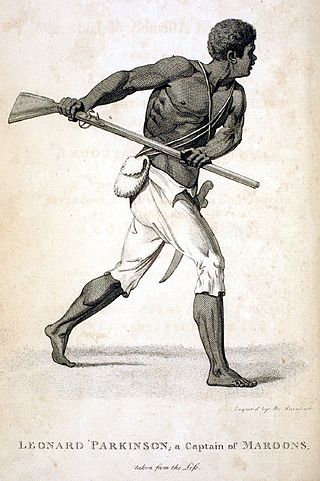Related Research Articles

Reggae is a music genre that originated in Jamaica in the late 1960s. The term also denotes the modern popular music of Jamaica and its diaspora. A 1968 single by Toots and the Maytals, "Do the Reggay", was the first popular song to use the word reggae, effectively naming the genre and introducing it to a global audience. While sometimes used in a broad sense to refer to most types of popular Jamaican dance music, the term reggae more properly denotes a particular music style that was strongly influenced by traditional mento as well as American jazz and rhythm and blues, and evolved out of the earlier genres ska and rocksteady. Reggae usually relates news, social gossip, and political commentary. It is instantly recognizable from the counterpoint between the bass and drum downbeat and the offbeat rhythm section. The immediate origins of reggae were in ska and rocksteady; from the latter, reggae took over the use of the bass as a percussion instrument.
Obeah, or Obayi, is a series of African diasporic spell-casting and healing traditions found in the former British colonies of the Caribbean. These traditions derive much from traditional West African practices that have undergone cultural creolization. There is much regional variation in the practice of Obeah, which is followed by practitioners called Obeahmen and Obeahwomen.

Maroons are descendants of Africans in the Americas and Islands of the Indian Ocean who escaped from slavery and formed their own settlements. They often mixed with indigenous peoples, eventually evolving into separate creole cultures such as the Garifuna and the Mascogos.
Old Nanny Town was a village in the Blue Mountains of Portland Parish, north-eastern Jamaica, used as a stronghold of Jamaican Maroons. They were led in the early 18th century by an Ashanti escaped slave known as Granny Nanny, or Queen Nanny. The town held out against repeated attacks from the colonial militia before being abandoned in 1734.

Queen Nanny, Granny Nanny, or Nanny of the Maroons ONH, was an 18th-century leader of the Jamaican Maroons. She led a community of formerly enslaved Africans called the Windward Maroons. In the early 18th century, under the leadership of Nanny, the Windward Maroons fought a guerrilla war over many years against British authorities in the Colony of Jamaica in what became known as the First Maroon War.

Jamaican Patois is an English-based creole language with West African influences, spoken primarily in Jamaica and among the Jamaican diaspora. A majority of the non-English words in Patois come from the West African Akan language. It is spoken by the majority of Jamaicans as a native language.

The Sierra Leonean Creole or Krio is an English-based creole language that is lingua franca and de facto national language spoken throughout the West African nation of Sierra Leone. Krio is spoken by 96 percent of the country's population, and it unites the different ethnic groups in the country, especially in their trade and social interaction with each other. Krio is the primary language of communication among Sierra Leoneans at home and abroad, and has also heavily influenced Sierra Leonean English. The language is native to the Sierra Leone Creole people, or Krios, a community of about 104,311 descendants of freed slaves from the West Indies, Canada, United States and the British Empire, and is spoken as a second language by millions of other Sierra Leoneans belonging to the country's indigenous tribes. English is Sierra Leone's official language, and Krio, despite its common use throughout the country, has no official status.
Grounation Day is an important Rastafari holy day, second only to Coronation Day. It is celebrated in honour of Haile Selassie's 1966 visit to Jamaica.

Abeng is a novel related to Maroons, published in 1984 by Michelle Cliff. It is a semi-fictional autobiographical novel about a mixed-race Jamaican girl named Clare Savage growing up in the 1950s. It explores the historical repression resulting from British imperialism in Jamaica. Facts regarding imperialism of the island are dispersed throughout the narrative, as well as facts about slavery in Jamaica and Jamaican folklore. It is emphasized that the protagonists are generally unaware of these facts, which often serve to reveal the brutal nature of both slavery and imperialism. In this way Cliff reveals her intentions for the book. It is a piece of revisionist literature meant to challenge the mainstream narrative of Jamaican history. The character Clare Savage would return in Michelle Cliff's next novel, No Telephone to Heaven (1987).
Maroon Music is a genre involving people of African descent that were not born on the continent creating songs in an African language. It is named after the Maroon (people), African refugees who escaped from slavery in the Americas and formed independent settlements. Just as the Maroon people created their own societies in lands foreign to them in attempts to retain their freedom, Maroon music is an attempt by African American artists to reacquire their Mother tongue through writing music in an indigenous African language. Maroon Music subject matter centers around stories about Maroon leaders and other historic freedom fighters of African descent, Maroon groups, peace, unity, and righteousness.
Michelle Carla Cliff was a Jamaican-American author whose notable works included Abeng (1985), No Telephone to Heaven (1987), and Free Enterprise (2004).
Cotterwood is a town in Saint Elizabeth Parish, Jamaica. It is at latitude 18° 4' 60" N, Longitude 77° 54' 0" W and at an altitude of 107 metres.
Jamaican Maroons descend from Africans who freed themselves from slavery on the Colony of Jamaica and established communities of free black people in the island's mountainous interior, primarily in the eastern parishes. Africans who were enslaved during Spanish rule over Jamaica (1493–1655) may have been the first to develop such refugee communities.
Moore Town is a Maroon settlement located in the Blue Mountains and John Crow Mountains of Portland, Jamaica, accessible by road from Port Antonio. The easternmost Maroon town, Moore Town is located in the eastern end of the parish. Formerly known as New Nanny Town, Moore Town was founded in 1740 when the Peace Treaty was signed between the British colonial authorities and the Windward Maroons. This treaty allotted the Moore Town Maroons 1000 acres, but Moore Town only received 500. In 1781 the initial 500 acres was augmented with another 500 acres, taking their communal land up to 1,000 acres.

Akan religion comprises the traditional beliefs and religious practices of the Akan people of Ghana and eastern Ivory Coast. Akan religion is referred to as Akom. Although most Akan people have identified as Christians since the early 20th century, Akan religion remains practiced by some and is often syncretized with Christianity. The Akan have many subgroups, so the religion varies greatly by region and subgroup. Similar to other traditional religions of West and Central Africa such as West African Vodun, Yoruba religion, or Odinani, Akan cosmology consists of a senior god who generally does not interact with humans and many gods who assist humans.
Buckra or Backra is a term of West African origin. It is mainly used in the Caribbean and in the Southeast United States. Originally, it was used by slaves to address their white slave master. Later the meaning was broadened to describe white people in general.
Juaben is a small town in the Ejisu-Juaben Municipal District, a district in the Ashanti Region of Ghana.

The Sierra Leone Creole people are an ethnic group of Sierra Leone. The Sierra Leone Creole people are descendants of freed African-American, Afro-Caribbean, and Liberated African slaves who settled in the Western Area of Sierra Leone between 1787 and about 1885. The colony was established by the British, supported by abolitionists, under the Sierra Leone Company as a place for freedmen. The settlers called their new settlement Freetown. Today, the Sierra Leone Creoles are 1.2 percent of the population of Sierra Leone.
The traditional Jamaican Maroon religion, otherwise known as Kumfu, was developed by a mixing of West and Central African religious practices in Maroon communities. While the traditional religion of the Maroons was absorbed by Christianity due to conversions in Maroon communities, many old practices continued on. Some have speculated that Jamaican Maroon religion helped the development of Kumina and Convince. The religious Kromanti dance is still practiced today but not always with the full religious connotation as in the past.

The sneng or snaeng is an aerophone made from an ox horn or water buffalo horn. It is loud enough to call across a distance and has been used in rural environments to signal mealtimes, give warning, call for help or indicate a need to return to the village. It was also used to call domestic elephants in from the field, and hunters communicated with it.
References
- ↑ Cassidy, Frederic Gomes; Page, Robert Brock Le (2002). Dictionary of Jamaican English. University of the West Indies Press. ISBN 9789766401276.
- ↑ Senior, Olive (2003). Encyclopedia of Jamaican heritage. St. Andrew, Jamaica, W.I.: Twin Guinep Publishers. ISBN 9768007141. OCLC 53403184.